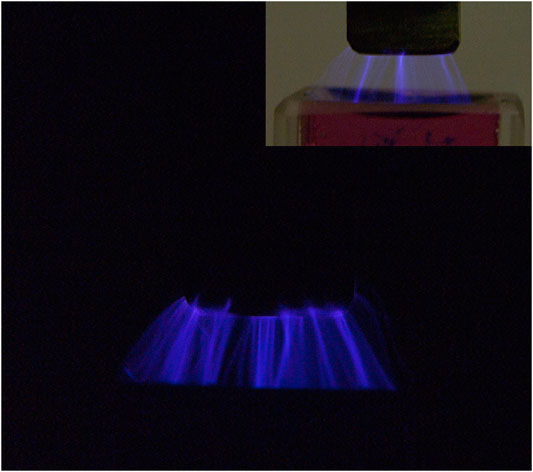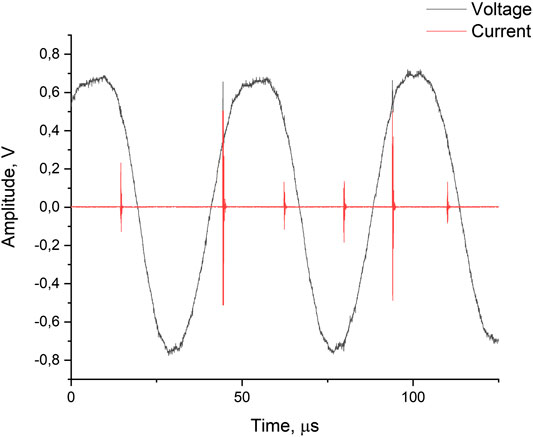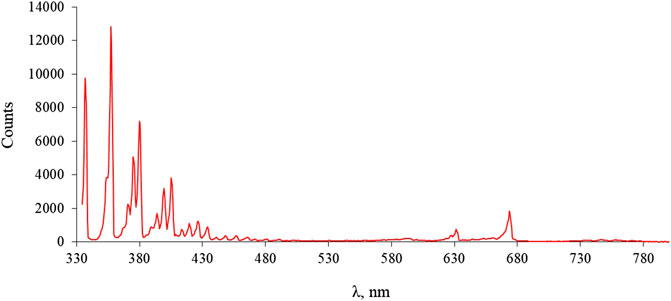- 1Prokhorov General Physics Institute of the Russian Academy of Sciences, Moscow, Russia
- 2All-Russia Research Institute for Phytopathology of the Russian Academy of Sciences, Big Vyazyomy, Moscow Region, Russia
- 3Laboratory Physics of liquids, Bauman Moscow State Technical University, Moscow, Russia
The distilled water was exposed to a cold atmospheric plasma (CAP) generated by the piezotransformer. The treatment was carried out on a six-well plate. Exposure time was from 30 s to 10 min. The emission spectra were obtained. Physical and chemical changes of activated water were observed for 8 days. The reactive oxygen and nitrogen species (RONS) were investigated. RONS production dependence on the exposure time and RONS lifetime in the treated liquid was determined using absorbance spectra. Quantitative assessment was made of the nitrite and nitrate concentration change over time after treatment. The medium conductivity and redox potential varied linearly depending on exposure time. The pH value change correlates with nitrate anion concentration. The concentration of peroxide hydrogen increased depending on CAP water treatment duration. The RONS concentration after liquid media processing with piezoelectric direct discharge CAP is a novel result. Biogeosystem Technique provides CAP activated water agriculture synergetic effect.
Introduction
Current agriculture badly influences the soil and plant health and productivity and is incapable of ensuring a sustainable ecosphere response to the high-tech stimulants [1–4]. The nonequilibrium nonthermal atmospheric plasma (cold plasma) has attracted researchers in various fields of medicine and biology, including agriculture, as a high-tech stimulant [5–8]. Cold plasma is helpful for the standard temperature and pressure liquid media and heat-sensitive materials processing. This is promising for the live biological targets processing that cannot withstand high temperature and reduced pressure. Cold plasma processing allows creating the new technologies in medicine, veterinary medicine, food industry, agriculture, and other fields of research and practice [9–12]. Several methods have been developed for generating the nonequilibrium atmospheric plasma at atmospheric pressure. Cold atmospheric plasma (CAP) could be generated using a gas flow (or the gas mixture flow) to produce the outlet plasma flux [13, 14]. This application of CAP is well documented in publications. One more CAP generation method is the stationary air volume processing. Dielectric barrier discharge (DBD) is used for the CAP excitation [15, 16]. The DBD current is limited to dozens of microamperes to exclude the treated surface high temperature. The DBD could be applied to various media: chemical compounds, energetic electrons and low-energy ions, electromagnetic fields, ultraviolet radiation, and other. The DBD not only modifies the object surface, but also changes the properties of biological environment being treated. The DBD synergistic effect in liquid media has been found useful for medical and biological application. Numerous works proved the CAP successful use for surfaces' sterilization, healing wounds, immunity stimulations, and other [11, 17–20]. This effect is used in medical CAP devices all over the world [21]. Of interest are results of the cell medium or organism exposure to CAP. The CAP has been applied directly on the medium with cells or to the fluid without cells and further addition of the processed fluid to the cell medium or organism. A cascade of chemical reactions occurs at the liquid-gas interface involving active particles generated in plasma. The main effect is the liquid enrichment with reactive oxygen species (ROS), such as hydroxyl radical (•OH), hydrogen peroxide (H2O2), peroxyl radical (HO2•), and superoxide anion radical (O2−•), as well as with reactive nitrogen species (RNS), such as nitrogen monoxide and peroxynitrite. Currently, there is a growing interest in pharmacology in CAP activated media. Thus, a new line of research has emerged—plasma pharmacy, whose results will be used later for the new drugs creation. Studies show that plasma-treated media can maintain bactericidal properties for a long time [19, 20, 22]. To describe the processes that occur when cold plasma acts on various objects and liquids, it is necessary to understand well what chemicals and in what proportions are formed in the processed medium itself, and how the cold plasma treatment mode affects the resulting product function and biological efficiency. The application of CAP for the liquid and soil media processing, as well as the processed media properties, is not well documented in publications.
As the CAP sources the laboratory prototype units created at the Prokhorov General Physics Institute of the Russian Academy of Sciences were used [23].
These devices were developed on the piezoceramic transformers basis [24]. CAP can be created using the inert gas (He or Ar) flow. In this study a direct atmosphere piezo-discharge has been used. The objects of the study were plasma activated media (PAM) and, in particular, plasma activated water (PAW) [25].
Conventional DBD power supply should be equipped with protective devices and ballast resistances to prevent an arc discharge. This limits the current and reduces system efficiency. The piezotransformer used in our work has an advantage. The unit does not allow an arc discharge, even with a short circuit in the output. When working on liquids, including water, we use a DBD short pulses set. Pulse duration is from 10 to 100 ns. Pulses are generated on the piezotransformer output electrode both in the positive and in the negative high voltage half-periods. These pulses form microdischarges moving along the surface of the liquid and creating conditions for the plasmochemical reactions in the processed media surface layer. The average temperature in the volume of liquid varies slightly. The unique transfer of chemical reactivity and energy from the gas phase to water occurs in the absence of any other chemicals but leads to a product with significant biological activity called plasma activated water (PAW). These features make PAW an environmentally friendly solution for a wide range of biotechnological applications, from water purification and seed treatment to pharmacology and biomedicine.
The measurement of RONS concentrations and redox properties changes in PAW generated with piezoelectric direct discharge CAP is a main novelty of the study.
Current agriculture needs for soil organic matter (SOM) and humic substances (HS) functioning stimulation [26]. A transcendental Biogeosystem Technique (BGT*) methodology was proposed for the long-term soil system improving and CAP activated water agricultural effective use [27, 28].
The aim of this paper was to study the CAP generation process using the Prokhorov General Physics Institute of the Russian Academy of Sciences original equipment, the piezoelectric direct discharge CAP treated liquid media properties, to propose the effective agricultural application of CAP activated water via BGT methodology.
Methods
In this work, the CAP was created using a laboratory prototype unit created at the Prokhorov General Physics Institute of the Russian Academy of Sciences. The prototype unit provides CAP excitation by the piezoelectric direct discharge. Excitation voltage changes from 2 to 4 kV. The piezotransformer resonant frequency is 20 kHz. The CAP generator total power consumption does not exceed 6 W. The single piezoelectric discharge to the processed media (distilled water or other) duration is about 10–20 ns [29].
The CAP liquid media treatment was carried out using standard six-well plate methodology. The six-well plate methodology allowed direct plasma treatment of the 5 ml liquid medium volume in each well. The exposure time was from 30 s to 10 min. Direct piezo-discharge device surface contains a set of streamers. Every streamer has been turned on sequentially. This operation mode provided permanent changing of the plasma discharge position on the treated surface or in the treated liquid volume. As a result, a mean water temperature increment rate did not exceed the value of 0.5 °C min−1. Figure 1 shows a direct piezo-discharge emission spectra measuring scheme.
The direct piezo-discharge CAP media treatment process is presented in Figure 2 [25].
The CAP induced RONS generation in PAW was studied at different plasma treatment regimes. Irradiation duration was different. The following PAW parameters were studied.
The oscillograms were made of the direct piezo-discharge CAP voltage and current.
The N2 rotational temperature after liquid media treatment with CAP was evaluated using the AvaSpec-2048 spectrometer (330–1,100 nm). The spectrometer was calibrated using AvaLight-HAL-CAL halogen light source. The rotational temperature N2 and vibrational temperatures were calculated via the standard procedure (see Results). The compound generation rate was estimated based on the treated medium ultraviolet absorption spectra change in the range of 190–280 nm [30]. Spectrophotometry was used for the media initial study. The UV radiation source was DDS-30 deuterium lamp. The UV radiation receiver was the AvaSpec-2048FT-4-RM spectrometer of the range of 199–320 nm (Figure 3). The power source was stabilized. The distance from the radiation source to the object was about 1.5 mm.
To obtain information on the RONS generation in distilled water, the UV radiation absorption spectra were studied at the various plasma treatment doses (the dose value depended on the radiation duration). Reference (normalizing) UV spectrum was recorded of UV radiation passed through a quartz cuvette with untreated distilled water. After that, the distilled water treated by CAP was poured in quartz cuvette.
UV study of the CAP treated water has been made in a quartz cuvette. The quartz cuvette transmits the UV radiation wavelength beginning from 190 nm. Cuvette internal transverse dimension was of 10 mm. The NO2− concentration was calculated from the absorbance curve. Water electrical conductivity was measured using a Cond 6 + conductometer (Eutech Instruments). The water redox potential was measured using an Expert 001–1 multielectrode meter (Econix). The pH value was obtained using the I-500 pH meter Aquilon. The H2O2 concentration was determined using the enhanced chemiluminescence method in the luminol-4-iodophenol-peroxidase system. More details of the developed experimental technique and standard methods used in research can be found in publications [31–33].
Results
Absorbance Spectrum of the Plasma Activated Water
The direct piezo-discharge CAP voltage and current plots are shown in Figure 4.
Figure 5 shows a typical piezo-discharge emission spectrum obtained using an AvaSpec-2048 spectrometer (330–1,100 nm). The rotational temperature N2 was calculated from the unresolved rotational structure of the 0→0 band radiation, while the value obtained was around Trot = 1,400 K.
Absorption was highest of nitrite ion (NO2−) and nitrate ion (NO3−) [25, 31].
The UV radiation spectrum passed through a quartz cuvette with CAP treated distilled water was divided into a reference spectrum. Figure 6 showed a UV transmission spectrum of the distilled water treated with piezo-discharge plasma for 30 s.
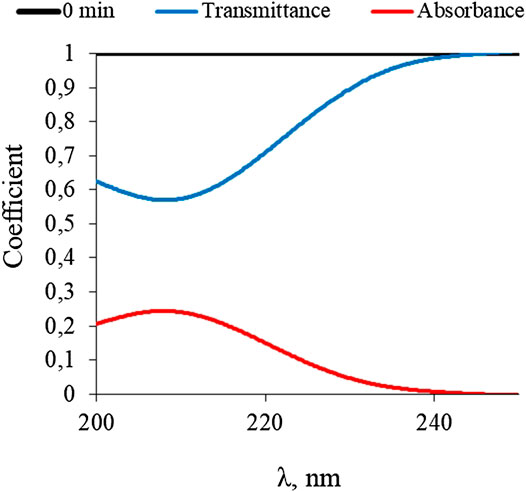
FIGURE 6. UV transmittance and absorbance spectrum of CAP activated water. The volume of treated water 5 ml, exposure time 30 s.
Maximal absorbance was registered at a wavelength of 209 nm. The absorbance decline was about 15–20% at the wavelength of 200 nm and 30–35% at the wavelength of 230 nm (Figure 6). The “transmittance” and “absorbance” curves in other publications on the CAP study look similar to Figure 6. Only peak amplitude differs. Figure 6 is important concerning the RONS concentration estimation technique. This figure shows that transmittance and absorbance extremums are related to a certain wavelength. This wavelength reflected a presence of the specific ions in the liquid. The decline of absorbance in a wavelength of 209 nm indicated the NO3−, H2O2, and O2 molecules contribution to the absorption, although the NO3− extinction coefficient was about two times higher than that of NO2−.
The nitrate concentration was calculated according to absorbance data (Figure 6) and assuming the fact that nitrite ion production was much higher than that of the nitrate ion. Nitrite ion (NO2−) production graph in distilled water (volume 5 ml) is presented in Figure 7 depending on the piezo-discharge exposure time.
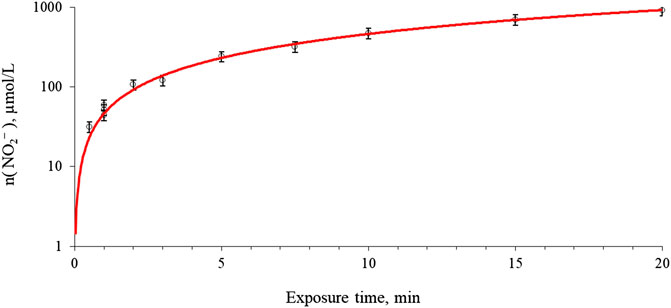
FIGURE 7. The generation of the nitrite ion (NO2–) (μmol L−1) in distilled water volume of 5 ml depending on direct piezo-discharge exposure time.
The initial time t = 0 min on Figures 8, 9 corresponds to the end of distilled water piezo-discharge processing procedure. The distilled water absorbance curve over time change after treatment for 3 min is shown in Figure 8.
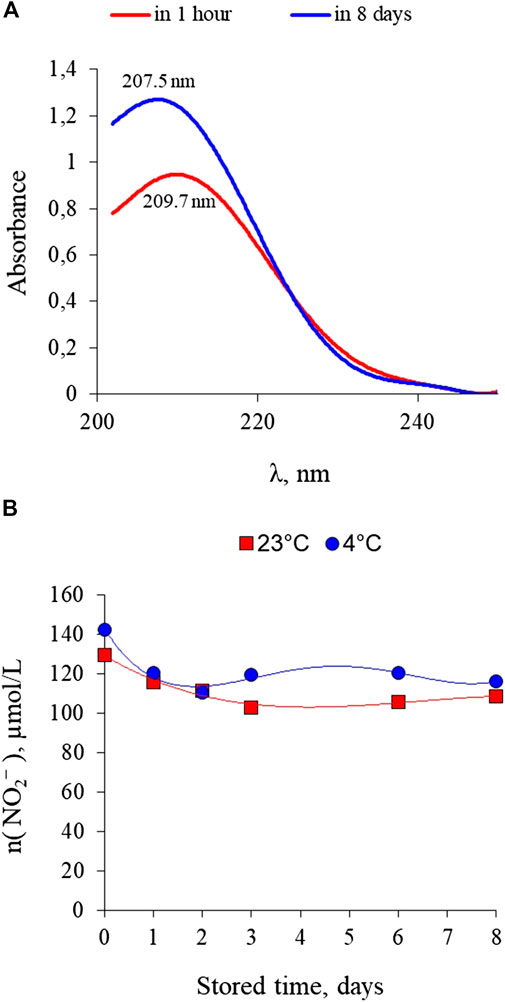
FIGURE 8. (A) Change with time of the absorbance curve of distilled water after treatment. Processing was carried out for 3 min in the well of the plate with a liquid volume of 5 ml. (B) The change in the concentration of nitrite ion (NO2–) in distilled water after treatment. Processing was carried out for 3 min in the well of the plate with a liquid volume of 5 ml, T1 = 23 °C, T2 = 4 °C.

FIGURE 9. Dependence of the treated media conductivity (A), redox potential (B), pH (C), and H2O2 concentration (D) on the exposure time. Measurements were taken immediately after processing and 24 h after processing.
The peak absorbance (Figure 8) increased and shifted toward a shorter wavelength in the 8 days after treatment in comparison with the data of 1 h after treatment. The wavelength region about 210–240 nm also shifted.
Figure 9 showed the NO2− concentration change in distilled water after direct piezo-discharge treatment. Optical absorption changes were tracked for 8 days. The measurements were carried out in two cuvettes. The first cuvette was kept at a room temperature of 23 °C. The second cuvette was placed in the refrigerator at a temperature of 4 °C. The results are close to one another.
The Main Reactive Oxygen and Nitrogen Species Characteristics of Distilled Water After the Liquid Treatment With Piezoelectric Direct Discharge Cold Atmospheric Plasma
Figure 10 showed the RONS parameter depending on the piezoelectric direct discharge cold plasma exposure time and the time of water preservation after CAP treatment. The piezotransformer, the power source, and over time water preservation regime after treatment were the same. The measurements were fulfilled immediately after CAP water treatment and 24 h later. The medium conductivity and redox potential changed linearly depending on exposure time. The pH value change correlates well with nitrate anion concentration. The H2O2 concentration was shown only for the moment 0 h to diversify Figure 10 look. This has been made because the H2O2 stability is similar to other RONS. The value of every RONS increased linearly depending on CAP water treatment duration. The RONS concentration including hydrogen peroxide remains at a certain level for several days (up to a month).
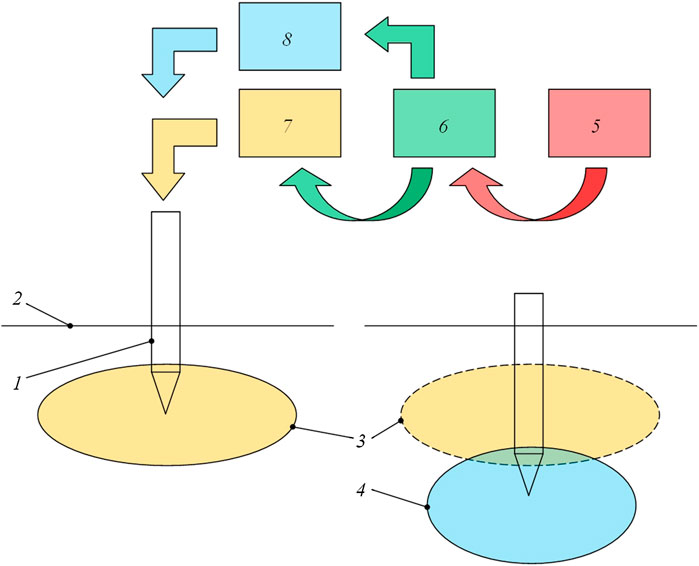
FIGURE 10. Method of liquid biological drug based on CAP activated water pulsed intrasoil discrete injection and followed pulsed intrasoil discrete watering with CAP activated water.
Robotic Plasma Activated Water Based Plant Protection System
The system was proposed for the plant protection via biological drug and CAP PAW synergy applied into soil (2) [35]. Method (Figure 11) envisages a pulsed intrasoil discrete injection of liquid biological drug based on CAP activated water (1, 3). Pulsed intrasoil discrete watering with CAP activated water (4) follows drug injection. The robotic system comprises energy supply unit (5), positioning and control unit (6), liquid biological drug source (7), and piezoelectric direct discharge CAP induced PAW source (8).
Discussion
The data showed that CAP water treatment provides a significant change of the liquid media properties. The PAW usefulness has already been revealed by long-term research in different scientific fields, including our contribution [25, 31–33].
The direct piezo-discharge CAP voltage and current (Figure 4) oscillograms were typical for the process.
The piezo-discharge emission spectrum in Figure 5 was a system of the various N2 bands. The rotational temperature N2 was around Trot = 1,400 K.
When treating with CAP, the long-lived RONS compounds appeared in the liquid. These were NO2−, NO3−, O2, H2O2, and other (1)–(5).
Nitrite ion (NO2−) content in PAW increased according to the piezo-discharge exposure time. Based on the absorbance change (Figure 8), it can be assumed that the nitrite ion is partially transformed over time after treatment to the nitrate ion. These processes can be described by chemical reactions (6)–8) [34].
The nitrate ion extinction coefficient was greater, and its peak absorbance was in the wavelength of 200 nm. Taking into account the small change of the value, a quantitative assessment was made of the nitrite ion concentration change over time after treatment. The evaluation was made based on absorbance at a wavelength of 230 nm. At this wavelength, the nitrite ion absorbance was greater than that of the nitrate ion.
The data on the nitrite concentration preservation in PAW depending on storage time are well documented for the standard CAP sources. The data of nitrite concentration depending on the storage time after the liquid piezoelectric direct discharge CAP processing (Figure 9) showed the nitrite ion (NO2−) preservation in PAW.
Nitrite ion (NO2−) content in PAW increased according to the piezo-discharge exposure time. In 8 days after PAW producing, the nitrite ion partially transforms to the nitrate ion [25].
The data obtained in this study using the piezoelectric direct discharge CAP have certain correspondence to the data obtained by the standard CAP generation methods. This fact is indirect evidence of this paper approach to PAW producing. Figures 4–9 data reliability can be assessed as well. RONS producing is a CAP generation and application to liquid media result. The RONS concentration in PAW after its processing with piezoelectric direct discharge CAP is a main novelty of the study. The results are promising for further research in various fields.
The data presented in Figures 4–9 showed that the PAW medium nitrite ion (NO2−) and nitrate ion (NO3−) content, electrical conductivity, redox potential, electrical conductivity, and H2O2 concentration strongly changed under the influence of CAP. These parameters are vital for the plant organogenesis. In plant organism and in rhizosphere, electrical conductivity, redox potential, pH, and hydrogen peroxide concentration are permanently changing via different biological regulatory mechanisms. If the physical methods of organogenesis stimulation successfully get to the biological material and signaling chains, this supports a biological process. On the one hand, the stimulation increases a production result of agrophytocenosis. On the other hand, the stimulation should be capable of providing the long-term soil system stability. There is a successful experience of PAW biological applications. Activated liquid is used in the biomedical and biological research and food preservation. A positive influence of PAW enriched with RONS (mainly H2O2 and NO2–) on plant growth is well documented [25, 31–33].
The H2O2 concentration, electrical conductivity, redox potential, and pH of water treated with piezoelectric direct discharge CAP are of great interest (Figure 10). PAW produced via piezoelectric direct discharge CAP is a new field of plant study. This kind of PAW is promising sphere for CAP agricultural application. In particular, there is a possibility to apply the liquid processed by piezoelectric direct discharge CAP into the soil.
Unfortunately, agriculture as the most important sphere of human activities in the biosphere is under the dominance of obsolete technical means and technologies contradicting the biological nature of soil and plants. This is the main cause of PAW and other up-to-date methods’ low agricultural result in plant and soil stimulation. The current agriculture technology equipment is its incapability to provide a PAW efficacy as there is no possibility to produce and immediately apply the PAW as a perishable short-term substance to plant and/or soil. This is a partial problem. But the main reason to reassess current agriculture technologies as a whole is their adverse and dangerous biosphere result.
The soils are degrading now. The water scarcity problem is getting worse. Waste recycling problem is insoluble in the current environmental technology framework [35]. The listed technological breakdowns cause the plant lower phytopathological resistance, adverse quality of agricultural production, and bad plant and soil health [36, 37]. The task is to save and expand the biological process on the Earth. The CAP activated water is capable of making a significant contribution to the modern environmental management problem resolution. But these opportunities now would be “dissolved” in the disadvantages of outdated technologies.
There is a need for utterly new approach to biosphere strategic management to use the CAP activated water biological opportunities successfully.
We have proposed a transcendental Biogeosystem Technique (BGT*) methodology for the long-term soil aggregate system and water regime improvement, providing environmentally safe organic and mineral wastes recycling and soil-microbiological community stimulation [35]. This methodology is an attempt to overcome the standard land use technologies drawbacks and increase the soil system continuity and its biological function and obtain better conditions for SOM and HS functioning and better spatial organization of soil structured polymicrobial biofilms. The BGT* components are soil geophysical conditioning via intrasoil milling of the 20–45 cm soil layer; pulse intrasoil continuously discrete watering for improved plant water regime; intrasoil substances application in the course of intrasoil milling. The BGT* methodology provides soil aggregate multilevel system formation and stability, optimized soil water regime, and water scarcity overcoming. This is helpful for biodegradation control, enriched nutrients biogeochemical cycling, higher soil C content, high soil productivity, plant resistance to phytopathogens stimulation, and soil health [36–40]. New high soil environment conditions are a priority for HS [41, 42] and successful CAP activated water application [31–33]. Plant stimulation is closely linked to the plant protection from pathogens. We proposed new transcendental system for the plant protection via biological drug and CAP activated water synergy applied to soil (Figure 11) [35]. The method envisages the liquid biological drug based on CAP activated water pulsed intrasoil discrete injection (1, 3) and followed pulsed intrasoil discrete watering (4) from the CAP activated water source (5).
The liquid biological drug supply and following watering (Figure 11) are provided by immersion of syringe element (1) into the soil (2). The biological drug provides pathogen suppression. The watering (4) is performed about 3–5 days after biological drug apply. The watering (4) is repeated in sequence if needed, about 3–4 times with a period about 3–7 days. The method provides improved conditions for the applied biological objects PAW stimulated development inside the soil. Moreover, the improved prerequisites are provided for the biological objects on the not-less-important stage of postapplication development via PAW stimulated water regular injection to the soil under the zone of biological objects development. This ensures reliable pathogens prevention, soil health, and high-quality biological production. The syringe element (1), energy supply unit (5), positioning and control unit (6), CAP induced PAW generation source (7) on a transportation unit (not shown in Figure 11) comprise a minimal component of the new robotic system for plant biological protection.
In this configuration, the PAW over time stability problem shifts to another focus. The combined system of activated water production and supply by a single device dramatically solves the problem of activated water parameters deterioration with time of storage, since the PAW is supplied into the soil immediately after the CAP water treatment. At the same time, the study of PAW stability after application to soil environment is urgent. The PAW stimulative effect potency and durability in soil are also important, including an indirect and delayed stimulating effect.
Conclusion
The Prokhorov General Physics Institute of the Russian Academy of Sciences laboratory prototype piezoelectric direct discharge units are a reliable source of CAP. The oscillogram, spectrometry, and UV study showed that distilled water treatment by direct piezo-discharge for 30 s and for 3 min mainly produced the nitrite ion persisting for the period of 8 days. Electrical conductivity, redox potential, and H2O2 concentration in CAP activated media increased with the treatment duration. The pH value, on the contrary, decreased depending on the duration of treatment, which is associated with the accumulation of nitrate and nitrite anions in the CAP activated medium. The energy-efficient CAP activated water can be applied in the agricultural technology framework for the SOM and HS better functioning, pathogens prevention, high-quality biological production, and soil health on the BGT methodology basis.
Data Availability Statement
The raw data supporting the conclusions of this article will be made available by the authors, without undue reservation.
Author Contributions
EK, KA, and LK conducted experiments. AG, DB, and VK participated in the processing of the results and their discussion. VK participated in writing the text of the manuscript.
Funding
This work was supported by a grant of the Ministry of Science and Higher Education of the Russian Federation for large scientific projects in priority areas of scientific and technological development (Grant No. 075-15-2020-774).
Conflict of Interest
The authors declare that the research was conducted in the absence of any commercial or financial relationships that could be construed as a potential conflict of interest.
Acknowledgments
The authors are grateful to the Center for Collective Use of the GPI RAS for the equipment provided.
References
1. Byerlee D, de Janvry A, Sadoulet E. Agriculture for development: toward a new paradigm. Annual Review of Resource Economics (2009) 1(15). doi:10.1146/annurev.resource.050708.144239
2. Dobrovolsky GV, Dokuchaev VV. Pedosphere—the shell of high concentration and diversity of life on Earth. In: Soil Science Society VI Congress; 2012 August 13–18; Petrozavod, Russia (2012).
3. Keesstra SD, Bouma J, Wallinga J, Tittonell P, Smith P, Cerdà A, et al. The significance of soils and soil science towards realization of the United Nations Sustainable Development Goals. Soil (2016) 2:111. doi:10.5194/soil-2-111-2016
4. Reid WV, Mooney HA, Cropper A, Capistrano D, Carpenter SR, Chopra K, et al. Millennium ecosystem Assessment (ecosystems and human well-being—synthesis (2005) 155 p.
5. Martusevich AK, Krasnova SY, Kostrov AV. Cold plasma as bioregulator: biophysical and physiological aspects. Bioradic Antioxi (2018) 5(3):4.
6. Brun P, Pathak S, Castagliuolo I, Palù G, Zuin M, Cavazzana R, et al. Human cathelicidin production by the cervix. PloS One (2014) 9(8). doi:10.1371/journal.pone.0103434
7. Jawaid P, Rehman MU, Zhao QL, Takeda K, Ishikawa K, Hori M, et al. Helium‐based cold atmospheric plasma‐induced reactive oxygen species‐mediated apoptotic pathway attenuated by platinum nanoparticles. J Cell Mol Med (2016) 20(9):1737. doi:10.1111/jcmm.12880
8. Semenov AP, Baldanov BB, TsV R, ChN N, Namsaraev BB, Dambaev VB, et al. Inactivation of microorganisms in cold argon plasma at the atmospheric pressure. Adv Appl Phys (2014) 2(3):229.
9. Kong MG, Kroesen G, Morfill G, Nosenko T, Shimizu T, van Dijk J, et al. Plasma medicine: an introductory review. New J Phys (2009) 11:115012 doi:10.1088/1367-2630/11/11/115012
10. Fridman A, Chirokov A, Gutsol A. Non-thermal atmospheric pressure discharges. J Phys D Appl Phys (2005) 38:R1.
11. Fridman G, Friedman G, Gutsol A, Shekhter AB, Vasilets VN, Fridman A. Atmospheric-pressure plasma sources: prospective tools for plasma medicine. Plasma Process Polym (2008) 5:503. doi:10.1351/PAC-CON-09-10-35
12. Wagner HE, Brandenburg R, Kozlov KV, Sonnenfeld A, Michel P, Behnke JF. The barrier discharge: basic properties and applications to surface treatment. Vacuum (2003) 71:417–36. doi:10.1016/S0042-207X(02)00765-0
13. Divya Deepak G, Joshi NK, Prakash R. Model analysis and electrical characterization of atmospheric pressure cold plasma jet in pin electrode configuration. AIP Adv (2018) 8:055321. doi:10.1063/1.5023072
14. Schmidt-Bleker A, Winter J, Bösel A, Reuter S, Weltmann K-D. On the plasma chemistry of a cold atmospheric argon plasma jet with shielding gas device. Plasma Sources Sci Technol (2016) 25:015005. doi:10.1088/0963-0252
15. Zhang J, Sun J, Wang D, Wang X-G. A novel cold plasma jet generated by atmospheric dielectric barrier capillary discharge. Thin Solid Films (2006) 506:404. doi:10.1016/j.tsf.2005.08.088.507
16. Bureyev O, Surkov YS, Spirina AV. Characteristics of cold atmospheric plasma source based on low-current pulsed discharge with coaxial electrodes. J Phys Conf (2017) 830:012051. doi:10.1088/1742-6596/830/1/012051
17. Park GY, Park SJ, Choi MY, Koo IG, Byun JH, Hong JW, et al. Atmospheric-pressure plasma sources for biomedical applications. Plasma Sources Sci Technol (2012) 21:043001. doi:10.1088/0963-0252/21/4/043001
18. von Woedtke T, Reuter S, Masur K, Weltmann KD. Plasmas for medicine. Phys Rep (2013) 530:291. doi:10.1016/j.physrep.2013.05.005
19. Duan J, Lu X, He G. The selective effect of plasma activated medium in an in vitro co-culture of liver cancer and normal cells. J Appl Phys (2017) 121:013302. doi:10.1063/1.4973484
20. Tanaka H, Ishikawa K, Mizuno M, Toyokuni S, Kajiyama H, Kikkawa F, et al. State of the art in medical applications using non-thermal atmospheric pressure plasma. Rev Modern Plasma Phys (2017) 1:89. doi:10.1007/s41614-017-0004-3
21. Reuter S, von Woedtke T, Weltmann K. The kINPen—a review on physics and chemistry of the atmospheric pressure plasma jet and its applications. J Phys D Appl Phys (2018) 51:233001. doi:10.1088/1361-6463/aab3ad
22. Kurake N, Tanaka H, Ishikawa K, Takeda K, Hashizume H, Nakamura K, et al. Effects of •OH and •NO radicals in the aqueous phase on H2O2 and NO2− generated in plasma-activated medium. J Phys D Appl Phys (2017) 50:155202. doi:10.1088/1361-6463/aa5f1d
23. Kolik LV, Kharchev NK, Borzosekov VD, Malakhov DV, Konchekov EM, Stepakhin VD, et al. Low temperature plasma generator. RU 181459 U1 (2018).
24. Johnson MJ, Boris DR, Petrova TB, Walton SG. Characterization of a compact, low-cost atmospheric-pressure plasma jet driven by a piezoelectric transformer. IEEE Trans Plasma Sci (2018) 47:434. doi:10.1109/TPS.2018.2870345
25. Artem’ev K, Kolik L, Podkovyrov L, Sevostyanov S, Kosolapov V, Meshalkin V, et al. Diuldin M Generation of plasma-activated water using a direct piezo-discharge: physicochemical aspects. IOP Conf Ser Earth Environ Sci (2019) 390:012039. doi:10.1088/1755-1315/390/1/012039
26. Kalinichenko VP, Glinushkin AP, Sokolov MS, Zinchenko VE, Minkina TM, Mandzhieva SS, et al. Impact of soil organic matter on calcium carbonate equilibrium and forms of Pb in water extracts from Kastanozem complex. J Soils Sediments (2018) 19:2717–28. 10.1007/s11368-018-2123-z
27. Endovitsky AP, Batukaev AA, Minkina TM, Kalinitchenko VP, Mandzhieva SS, Sushkova SN, et al. Ions association in soil solution as the cause of lead mobility and availability after application of phosphogypsum to chernozem. J Geochem Explor (2017) 182B:185.
29. Yemelyanov OA, Petrova NO, Smirnova NV, Shemet MV. The development and application of a cold atmospheric plasma generator for treatment of skin and soft-tissue injuries in animals. Lett J Tech Phys (2017) 43:30.
30. Oh J, Szili EJ, Gaur N, Hong S, Furuta H, Kurita H, et al. How plasma induced oxidation, oxygenation, and de-oxygenation influences viability of skin cells. J Phys D Appl Phys (2016) 49:304005. doi:10.1063/1.4967880
31. Barmina EV, Gudkov SV, Simakin AV, Shafeev GA. Stable products of laser-induced breakdown of aqueous colloidal solutions of nanoparticles. J Laser Micro/Nanoeng (2017) 12:254.
32. Gudkov SV, Garmash SA, Shtarkman IN, Chernikov AV, Karp OE, Bruskov VI. Long-lived protein radicals induced by X-ray irradiation are the source of reactive oxygen species in aqueous medium. Dokl Biochem Biophys (2010) 430:1.
33. Gudkov SV, Guryev EL, Gapeyev AB, Sharapov MG, Bunkin NF, Shkirin AV, et al. Unmodified hydrated С60 fullerene molecules exhibit antioxidant properties, prevent damage to DNA and proteins induced by reactive oxygen species and protect mice against injuries caused by radiation-induced oxidative stress. Nanomed Nanotechnol Biol Med (2019) 15:37. doi:10.1016/j.nano.2018.09.001
34. Simakin AV, Astashev ME, Baimler IV, Uvarov OV, Voronov VV, Vedunova MV, et al. The effect of gold nanoparticle concentration and laser fluence on the laser-induced water decomposition. J Phys Chem B (2019) 123:1869. doi:10.1021/acs.jpcb.8b11087
35. Kalinichenko VP, Glinushkin AP, Sokolov MS, Budynkov NI, Zinchenko VE, Chernenko VV, et al. Special arrangements for delivering the liquid directly into the soil. Patent RU 2720634 C1 (2020).
36. Kalinitchenko VP. Optimizing the matter flow in biosphere and the climate of the Earth at the stage of technogenesis by methods of biogeosystem technique (problem-analytical review). Int J Environ Probl (2016) 4:99.
37. Glinushkin AP, Kudeyarov VN, Sokolov MS, Zinchenko VE, Chernenko VV. Nature-similar technologies of the biogeosystem technique in solving a global social and environmental problem. Biogeosystem Tech (2018) 5:159.
38. Piccolo A, Spaccini R, Savy D, Drosos M, Cozzolino V. Sustainable agrochemistry: a compendium of technologies (2019) p. 183.
39. Swidsinski A. The colonic bioreactor—a forerunner model for future biotechnology (function, role, products and management). In: Conference: fifth international conference of CIS IHSS on humic innovative technologies “humic substances and living systems”; 2019 October 19–23; Moscow, Russia.
40. Kalinitchenko VP, Glinushkin AP, Sokolov MS, Sharshak VK, Ladan EP, Minkina TM, et al. Nature-based technologies of biogeosystem Technique. Agrochemistry (2020) 2:61–8.
41. Volikov AB, Ponomarenko SA, Lasareva EV, Parfyonova AM, Perminova IV, Kholodov VA, et al. Silanized humic substances act as hydrophobic modifiers of soil separates inducing formation of water-stable aggregates in soils. Catena (2016) 137:229.
Keywords: piezoelectric direct discharge, reactive oxygen and nitrogen species, plasma activated water, dielectric barrier discharge, cold atmospheric plasma
Citation: Konchekov EM, Glinushkin AP, Kalinitchenko VP, Artem’ev KV, Burmistrov DE, Kozlov VA and Kolik LV (2021) Properties and Use of Water Activated by Plasma of Piezoelectric Direct Discharge. Front. Phys. 8:616385. doi: 10.3389/fphy.2020.616385
Received: 12 October 2020; Accepted: 11 November 2020;
Published: 27 January 2021.
Edited by:
Alexander Vladimirovich Simakin, Prokhorov General Physics Institute (RAS), RussiaReviewed by:
Denis Chausov, Moscow State Regional University, RussiaAlexander Melnikov, Kurchatov Institute, Russia
Copyright © 2021 Konchekov, Glinushkin, Kalinitchenko, Artem'ev, Burmistrov, Kozlov and Kolik. This is an open-access article distributed under the terms of the Creative Commons Attribution License (CC BY). The use, distribution or reproduction in other forums is permitted, provided the original author(s) and the copyright owner(s) are credited and that the original publication in this journal is cited, in accordance with accepted academic practice. No use, distribution or reproduction is permitted which does not comply with these terms.
*Correspondence: Evgeny M. Konchekov, ZXVrbWVrQGdtYWlsLmNvbQ==
 Evgeny M. Konchekov
Evgeny M. Konchekov Alexey P. Glinushkin2
Alexey P. Glinushkin2 Dmitry E. Burmistrov
Dmitry E. Burmistrov
